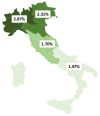Outpatient Testing for HIV in Italy, 2018-2023-Preliminary Data
- PMID: 40142547
- PMCID: PMC11946390
- DOI: 10.3390/microorganisms13030655
Outpatient Testing for HIV in Italy, 2018-2023-Preliminary Data
Abstract
HIV testing is crucial towards the control of the Acquired Immune Deficiency Syndrome (AIDS) epidemic. Monitoring trends of human immunodeficiency virus (HIV) testing over time may help interpret the incidence of new HIV diagnoses and effectiveness of HIV testing strategies. We started a research project aimed at assessing testing rates for HIV infection among Italian outpatients in 2018-2023. Numeric data for screening, confirmatory, and monitoring tests obtained by a national register were compared with the numbers of adult residents, newly diagnosed HIV infections, and patients undergoing treatment. The number of screening tests declined from 1,133,377 in 2018 to 889,972 in 2020 and increased to 1,096,822 in 2023. HIV-RNA tests showed a similar pattern, whereas confirmatory immunoblots did not vary significantly over time. The ratio of screening tests to adult residents was higher in North-West (2.87%) and North-East (2.31%) Italy compared to South Italy and the islands (1.47%), indicating that screening should be enhanced in the latter area. We observed differences between the ratio of screening tests and the incidence of newly diagnosed HIV infections by geographic area. Discrepancies in the number of screening and confirmatory tests needed for each new diagnosis suggest repeated testing on people already diagnosed and possible data reporting issues. The monitoring of HIV screening tests at the national and regional levels can provide essential data to interpret trends in HIV epidemiology and plan relevant testing strategies over time.
Keywords: HIV diagnosis; HIV epidemiology; HIV testing; diagnostic algorithms; population screening; supplemental tests.
Conflict of interest statement
The authors declare no conflicts of interest.
Figures






References
-
- UNAIDS 90-90-90 An Ambitious Treatment Target to Help End the AIDS Epidemic. UNAIDS/JC2684 (English original, October 2014) [(accessed on 23 January 2025)]. Available online: https://www.unaids.org/sites/default/files/media_asset/90-90-90_en.pdf.
-
- The Path That Ends AIDS: UNAIDS Global AIDS Update 2023. Geneva: Joint United Nations Programme on HIV/AIDS. Licence: CC BY-NC-SA 3.0 IGO. 2023. [(accessed on 23 January 2025)]. Available online: https://thepath.unaids.org/wp-content/themes/unaids2023/assets/files/202....
-
- Regine V., Pugliese L., Ferri M., Santaquilani M., Suligoi B. Aggiornamento delle nuove diagnosi di infezione da HIV e dei casi di AIDS in Italia al 31 dicembre 2023. Not. Ist. Sup. Sanità. 2024;37:3–59.
-
- AMCLI ETS Percorso Diagnostico “Infezioni da HIV”–Rif. 2023-03, rev. 2023. [(accessed on 23 January 2025)]. Available online: https://www.amcli.it/wp-content/uploads/2024/02/2023-03_INFEZIONI-DA-HIV....
Grants and funding
LinkOut - more resources
Full Text Sources

